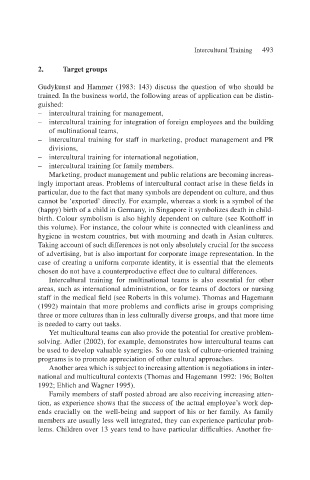Page 515 - Handbooks of Applied Linguistics Communication Competence Language and Communication Problems Practical Solutions
P. 515
Intercultural Training 493
2. Target groups
Gudykunst and Hammer (1983: 143) discuss the question of who should be
trained. In the business world, the following areas of application can be distin-
guished:
– intercultural training for management,
– intercultural training for integration of foreign employees and the building
of multinational teams,
– intercultural training for staff in marketing, product management and PR
divisions,
– intercultural training for international negotiation,
– intercultural training for family members.
Marketing, product management and public relations are becoming increas-
ingly important areas. Problems of intercultural contact arise in these fields in
particular, due to the fact that many symbols are dependent on culture, and thus
cannot be ‘exported’ directly. For example, whereas a stork is a symbol of the
(happy) birth of a child in Germany, in Singapore it symbolizes death in child-
birth. Colour symbolism is also highly dependent on culture (see Kotthoff in
this volume). For instance, the colour white is connected with cleanliness and
hygiene in western countries, but with mourning and death in Asian cultures.
Taking account of such differences is not only absolutely crucial for the success
of advertising, but is also important for corporate image representation. In the
case of creating a uniform corporate identity, it is essential that the elements
chosen do not have a counterproductive effect due to cultural differences.
Intercultural training for multinational teams is also essential for other
areas, such as international administration, or for teams of doctors or nursing
staff in the medical field (see Roberts in this volume). Thomas and Hagemann
(1992) maintain that more problems and conflicts arise in groups comprising
three or more cultures than in less culturally diverse groups, and that more time
is needed to carry out tasks.
Yet multicultural teams can also provide the potential for creative problem-
solving. Adler (2002), for example, demonstrates how intercultural teams can
be used to develop valuable synergies. So one task of culture-oriented training
programs is to promote appreciation of other cultural approaches.
Another area which is subject to increasing attention is negotiations in inter-
national and multicultural contexts (Thomas and Hagemann 1992: 196; Bolten
1992; Ehlich and Wagner 1995).
Family members of staff posted abroad are also receiving increasing atten-
tion, as experience shows that the success of the actual employee’s work dep-
ends crucially on the well-being and support of his or her family. As family
members are usually less well integrated, they can experience particular prob-
lems. Children over 13 years tend to have particular difficulties. Another fre-

